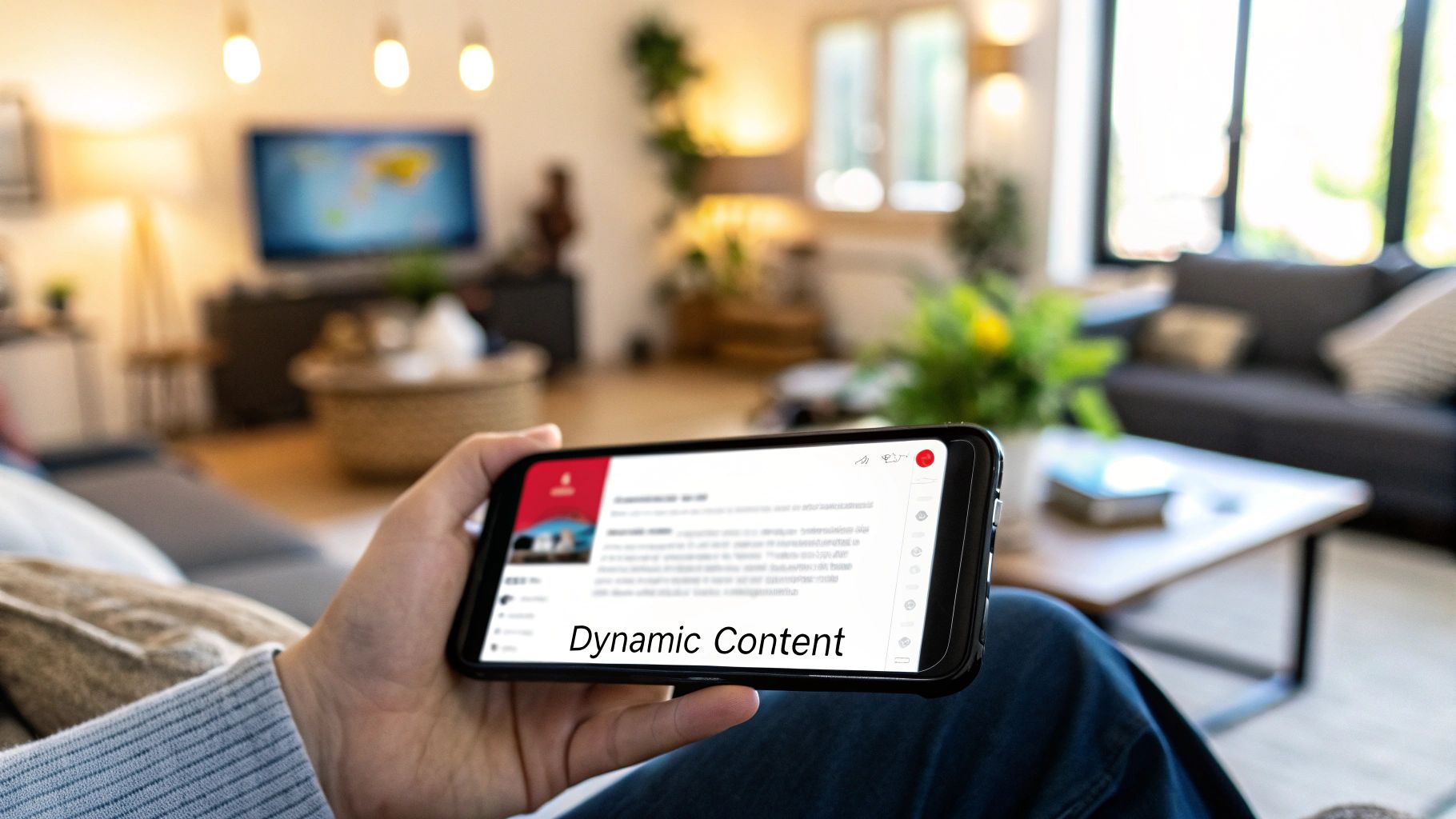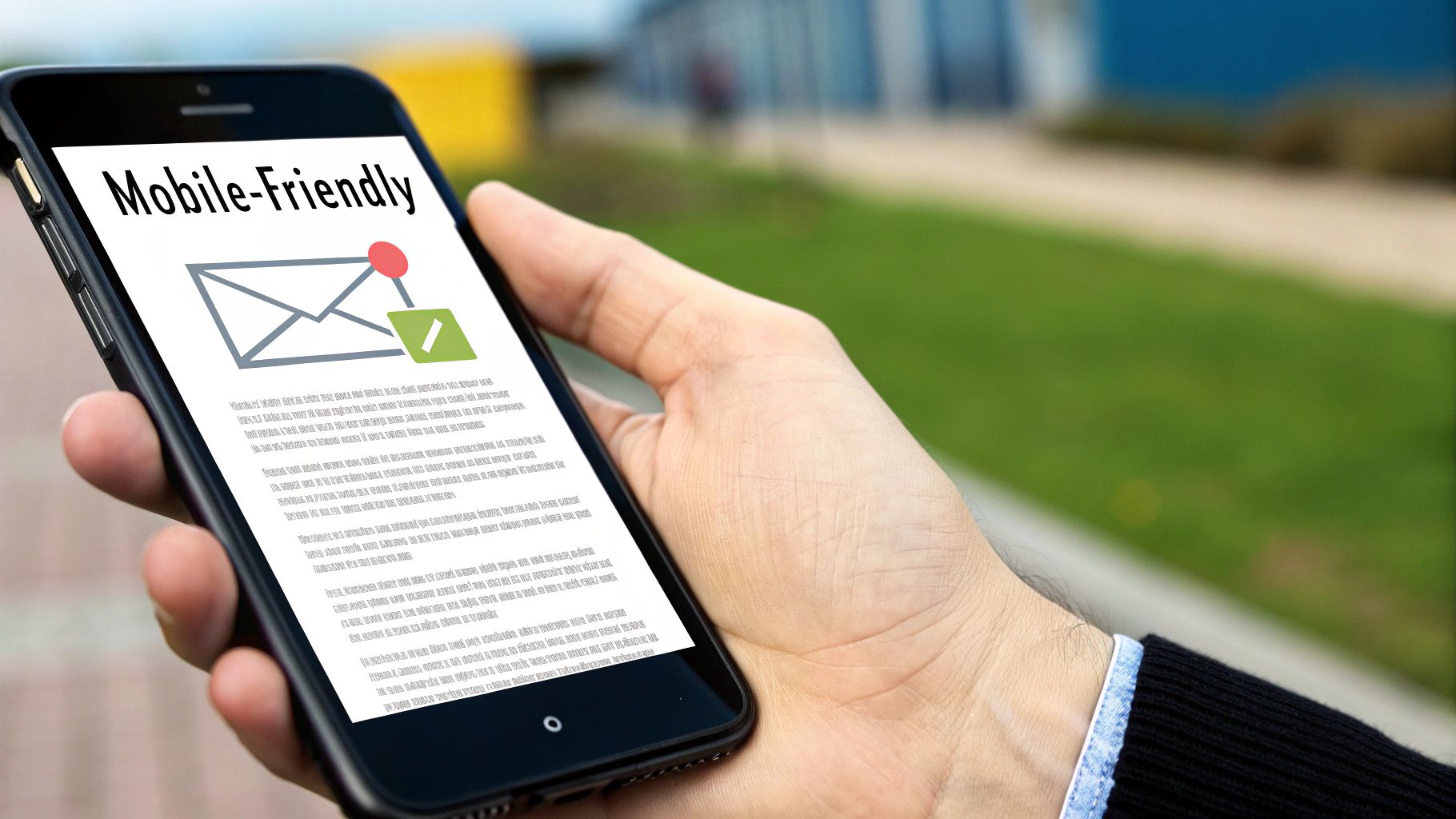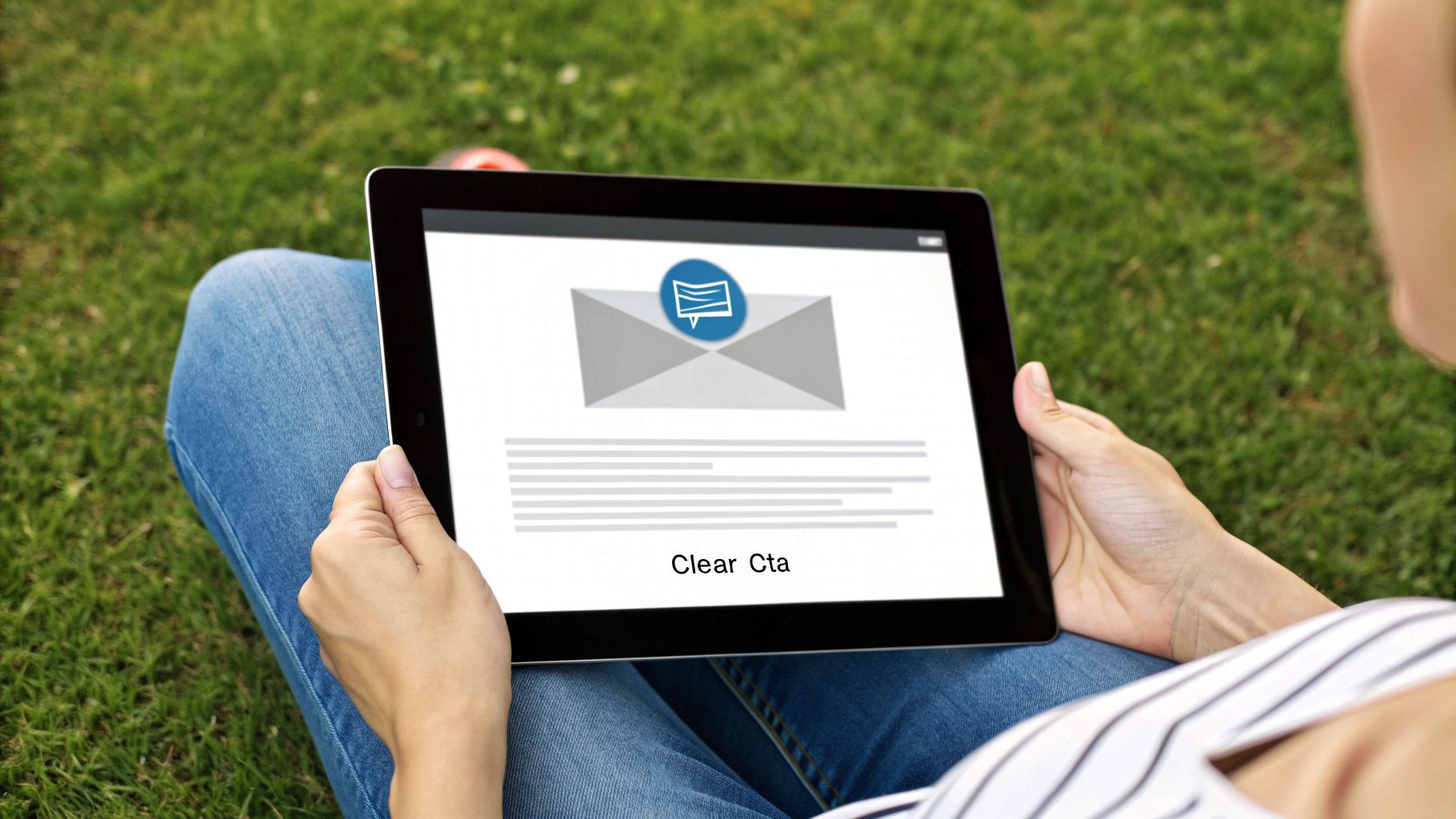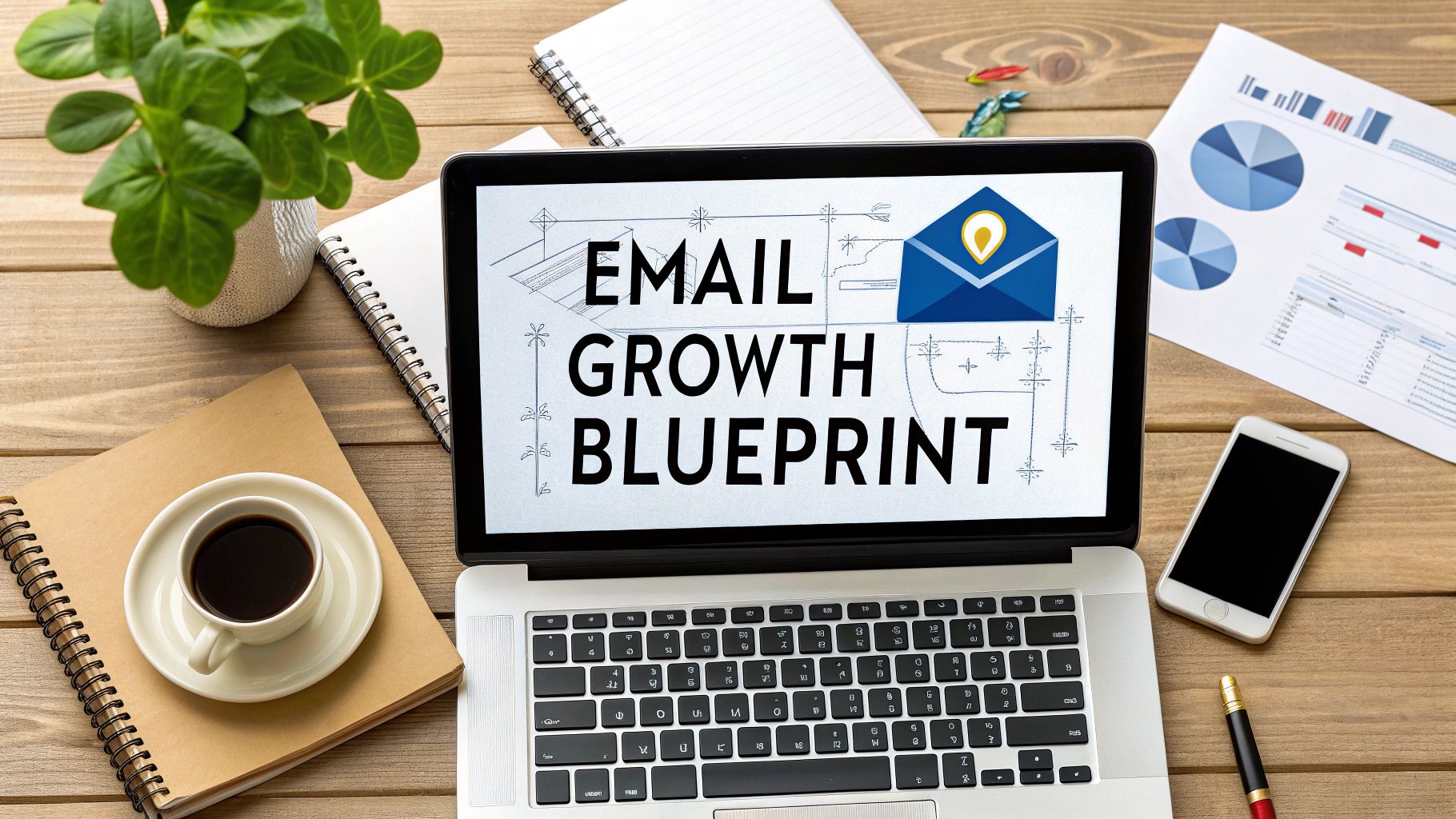In a crowded digital marketplace, simply sending emails is not enough. To capture attention, nurture leads, and drive real revenue, small and medium-sized businesses must adopt a sophisticated and strategic approach. This guide cuts through the noise to deliver a curated list of essential email marketing best practices that are critical for achieving tangible growth. We move beyond generic advice to provide actionable, detailed strategies you can implement immediately.
This article is structured to help you master every facet of your email program. We will explore how to build a high-quality list from scratch, craft compelling messages that convert, and automate your workflows for maximum efficiency and impact. You'll learn the secrets behind advanced segmentation, hyper-personalisation, bulletproof deliverability, and data-driven optimisation. Whether you're refining an existing strategy or building one from the ground up, these insights will help you create campaigns that not only reach the inbox but also resonate deeply with your audience.
For a holistic approach to elevating your email strategy, exploring a broader guide on comprehensive email marketing best practices can provide additional context and techniques. By applying these proven methods, businesses in Norfolk and Suffolk can foster genuine customer loyalty and achieve measurable growth, ensuring your digital marketing efforts are both powerful and effective. Let's dive into the practices that will transform your inbox strategy and turn your email list into one of your most valuable assets.
1. Email List Segmentation
Email list segmentation is the strategic practice of dividing your total email subscriber list into smaller, more focused groups. These groups, or segments, are based on specific, shared criteria, allowing you to move away from generic, one-size-fits-all broadcasts and towards highly personalised communication. This approach is fundamental to effective email marketing best practices because it ensures your messages resonate with the recipients, leading to significantly higher engagement and conversion rates.

When you send a message that directly addresses a subscriber’s interests, past behaviour, or needs, you build a stronger connection and demonstrate that you value their custom. Instead of ignoring your emails, they begin to anticipate them.
Why It’s a Best Practice
Segmentation transforms your email marketing from a loudspeaker into a one-on-one conversation. Consider how Netflix recommends shows based on your viewing history or how Amazon suggests products similar to what you’ve previously purchased. They are leveraging segmentation to deliver a hyper-relevant experience. For a small business in East Anglia, this could mean segmenting customers by location (e.g., Norwich vs. Cambridge) to promote local events or sending special offers to customers who haven’t made a purchase in the last six months to re-engage them.
How to Implement Segmentation
Getting started with this email marketing best practice doesn't have to be complex. You can begin with simple categories and expand as you gather more data.
- Demographic Segmentation: Group subscribers by age, gender, location, or job title. This is a great starting point for tailoring your messaging.
- Behavioural Segmentation: Create segments based on how subscribers interact with your website and emails. Examples include purchase history, browsing behaviour (pages visited), and email engagement (opens and clicks).
- Engagement Level: Organise your list into categories like ‘highly engaged’, ‘somewhat engaged’, and ‘inactive’. This allows you to reward loyal followers and run targeted re-engagement campaigns for those who have lost interest.
By implementing even basic segmentation, you align your content with your audience's expectations, making your emails more valuable and effective.
2. Personalization and Dynamic Content
Personalization in email marketing is the art of tailoring your communications to the individual subscriber. It moves beyond simply using a recipient's first name in the subject line and involves customising the entire message, from the offers presented to the imagery used, based on their unique data, preferences, and behaviour. This is where dynamic content becomes a powerful tool, allowing you to display different content blocks to various subscriber segments within a single email campaign.

Implementing this email marketing best practice makes your audience feel seen and understood. When an email reflects a customer's recent browsing history or past purchases, it transforms from a generic advertisement into a helpful, personalised recommendation, dramatically increasing its relevance and impact.
Why It’s a Best Practice
Personalization is what separates a forgettable email from an engaging one. E-commerce giants like Amazon excel at this, showing you products related to your recent searches and purchases. Similarly, Netflix’s content suggestions are driven by your viewing habits. This level of customisation builds trust and loyalty. For a boutique in Bury St Edmunds, this could mean sending an email featuring new arrivals from a brand a customer has previously purchased, or for a B2B service in Ipswich, it could involve sending case studies relevant to a prospect's specific industry.
How to Implement Personalization
You can introduce personalization and dynamic content gradually, building complexity as you gather more data and become more confident.
- Start with the Basics: Begin by using merge tags for the subscriber's name and location. Mentioning their city or region can make offers feel more exclusive and relevant.
- Leverage Behavioural Data: Use purchase history to recommend complementary products or send timely reminders for re-orders. Abandoned cart emails are a highly effective form of behavioural personalization.
- Use Dynamic Content Blocks: Show different calls-to-action or product showcases based on segments. For example, display your menswear collection to your male subscribers and your womenswear collection to female subscribers, all within the same email send.
- Ensure Data Accuracy: Personalization relies on clean, accurate data. Regularly audit your contact information to avoid mistakes like incorrect names or irrelevant recommendations, which can damage the customer experience.
By carefully personalising your emails, you prove to subscribers that you are paying attention, making your marketing efforts more effective and profitable.
3. Mobile-First Email Design
Mobile-first email design is an essential approach that prioritises the mobile viewing experience from the very beginning of the creative process. Given that a significant majority of emails are now opened on smartphones, designing for the smallest screen first ensures your message is readable, engaging, and fully functional for the largest portion of your audience. This practice is a cornerstone of modern email marketing best practices because it directly addresses user behaviour, preventing the frustration of pinching and zooming that leads to high deletion rates.

By creating a responsive template that adapts seamlessly from a mobile phone to a desktop computer, you guarantee a consistent and positive brand experience. This approach shows respect for your subscribers' time and preferred way of interacting with content, making them more likely to act on your call-to-action.
Why It’s a Best Practice
Adopting a mobile-first mindset acknowledges the reality of how people consume digital content today. Think of the clean, simple receipt emails from Uber or the promotional messages from Starbucks; they use large, tappable buttons and a clear, single-column layout that is effortless to navigate on a phone. For a local retailer in Ipswich, this means ensuring your weekly offers are just as compelling on a small screen during a commute as they are on a laptop at home.
Prioritising mobile design isn't just about aesthetics; it's about accessibility and performance. It forces you to be concise with your copy and focus on the most critical elements of your message, which ultimately benefits all users, regardless of their device.
How to Implement Mobile-First Design
Integrating this email marketing best practice into your workflow involves focusing on simplicity and functionality. Start with these core principles and build your designs outwards for larger screens.
- Use a Single-Column Layout: This is the most reliable structure for ensuring your content stacks vertically and remains readable on narrow screens without horizontal scrolling.
- Make Buttons Tappable: Ensure all call-to-action buttons and links are at least 44×44 pixels. This size accommodates fingertips and prevents accidental clicks, improving the user experience.
- Keep Subject Lines Concise: Mobile devices often truncate subject lines. Aim for under 50 characters to ensure your key message is visible in crowded inboxes.
- Optimise Your Images: Use alt text for all images in case they fail to load due to poor connectivity or user settings. This ensures your message is still understood. Always test your emails on various mobile devices and clients to catch any rendering issues.
4. Compelling Subject Lines and Preheaders
Your subject line and the accompanying preheader text are the gatekeepers of your email. They are the very first elements a recipient sees in a crowded inbox, making them pivotal for achieving high open rates. An effective subject line must be clear, compelling, and instantly relevant to the recipient, while the preheader offers a valuable extension to provide extra context and incentivise the open.

Think of the subject line as the headline of a newspaper article and the preheader as the first sentence. Together, they must capture attention and promise value. This combination is a cornerstone of email marketing best practices because without a compelling reason to click, even the most beautifully crafted email will remain unread.
Why It’s a Best Practice
Mastering subject lines and preheaders is one of the highest-leverage activities in email marketing. A strong opening can dramatically improve your open rates, which directly impacts every other metric, from click-throughs to conversions. Brands like BuzzFeed are famous for their curiosity-stoking subject lines ("This Will Make You Cry"), while TheSkimm uses a conversational tone to build rapport ("What you need to know today").
For a UK-based business, this could mean using a subject line like, "Your Exclusive Preview of Our Summer Collection" with a preheader that adds, "Plus, free UK delivery on all orders." This pairing delivers immediate value and a clear call to action before the email is even opened. An effective subject line strategy is a key component in any eCommerce conversion rate optimisation effort.
How to Implement Compelling Subject Lines and Preheaders
You can immediately improve your email performance by adopting a more strategic approach to your opening lines.
- Create Curiosity and Urgency: Use intrigue or a sense of scarcity to encourage immediate action. For example, "Your 24-hour flash sale access starts now." Be careful not to be misleading or overly aggressive.
- Personalise and Specify: Include the recipient's name or reference their past behaviour. Subject lines with numbers also perform well, such as "3 reasons your competitors are outranking you."
- Optimise the Preheader: Don't let your preheader default to "View this email in your browser." Use it to complement the subject line. If the subject is "Your Weekly Deals Are Here," the preheader could be "Save up to 40% on top-rated tech."
- A/B Test Everything: Regularly test different approaches to see what resonates with your audience. Test questions versus statements, short versus long, and emojis versus no emojis to continually refine your strategy.
5. Automated Email Sequences and Drip Campaigns
Email automation is the powerful practice of creating and sending triggered email sequences that reach subscribers based on their specific actions, behaviours, or timelines. These automated workflows, often called drip campaigns, work tirelessly in the background to nurture leads, onboard new customers, and re-engage inactive subscribers. This approach is a cornerstone of modern email marketing best practices because it allows you to deliver timely, relevant, and personalised messages at scale without manual intervention.
By automating your communication, you can guide each subscriber along their unique customer journey. This ensures that every individual receives the right information at the exact moment they need it, building trust and momentum towards conversion.
Why It’s a Best Practice
Automation transforms your email strategy from a series of disjointed broadcasts into a cohesive, intelligent system. Think of Dropbox's onboarding sequence, which guides new users through key features one step at a time, or Duolingo's friendly reminders that encourage you to return to the app when you miss a practice session. These companies use automation to create a seamless and supportive user experience that drives long-term engagement.
For a small business, this could mean setting up a welcome series for new subscribers or an abandoned cart sequence to recover lost sales. The result is a highly efficient marketing engine that fosters relationships and drives revenue around the clock.
How to Implement Automation
Getting started with this email marketing best practice is more accessible than ever with modern email platforms. The key is to begin with a clear goal in mind.
- Map the Customer Journey: Before building any workflow, outline the key stages and touchpoints a customer has with your brand. This map will reveal the best opportunities for automation.
- Start with Simple Workflows: Begin with foundational sequences like a welcome series for new sign-ups or a simple abandoned cart reminder. You can add complexity as you become more comfortable. When designing your sequences, leveraging effective sales follow-up email templates can significantly improve engagement and conversion rates.
- Audit and Optimise Regularly: Your automated campaigns aren't "set and forget". Periodically review their performance, test different subject lines or content, and update the information to ensure they remain effective and relevant.
6. A/B Testing and Optimisation
A/B testing, also known as split testing, is a methodical approach to comparing two versions of a single email to determine which one performs better. By sending 'Variation A' to one segment of your audience and 'Variation B' to another, you can gather empirical data on what truly captures their attention. This data-driven process is one of the most powerful email marketing best practices for moving beyond guesswork and systematically improving your campaign performance over time.
This practice allows you to refine everything from your subject lines and calls-to-action (CTAs) to your email design and send times. The goal is to make small, incremental changes that lead to significant improvements in your key metrics, such as open rates, click-through rates, and ultimately, conversions.
Why It’s a Best Practice
A/B testing removes assumptions from your marketing strategy and replaces them with hard evidence. It allows even a small business in Suffolk to make decisions based on what their specific audience responds to, not just what general articles suggest. For instance, the Obama administration's 2012 campaign famously used A/B testing on email subject lines, which reportedly helped them raise an additional $690 million. On a smaller scale, a local retailer could test a subject line like "20% Off This Weekend" against "Your Exclusive Weekend Discount," letting customer behaviour dictate the winning approach.
How to Implement A/B Testing
Integrating this email marketing best practice into your routine is straightforward with most modern email platforms like Mailchimp or Campaign Monitor.
- Isolate One Variable: To get clear, reliable results, only test one element at a time. For example, test two different subject lines but keep the email body, images, and CTA identical.
- Ensure a Sufficient Sample Size: Your test needs to be statistically significant. While there's no magic number, aim for at least 1,000 subscribers in each test group to ensure your results are reliable and not just a random fluke.
- Focus on High-Impact Elements: Start by testing the elements that will most directly affect your goals. Prioritise subject lines to improve open rates, CTA button colour and text to increase clicks, and send times to maximise visibility.
- Document and Learn: Keep a record of every test, including your hypothesis, the variations, the results, and what you learned. This creates a valuable internal resource for optimising all future campaigns.
7. List Building and Opt-in Strategies
Effective list building is the foundation upon which all successful email marketing is built. It's the process of actively encouraging and converting website visitors into email subscribers through valuable incentives and strategically placed opt-in forms. This practice prioritises quality over quantity, ensuring your subscribers are genuinely interested in your brand, which directly translates to better engagement, higher conversions, and improved email deliverability.
This is a core component of any robust digital marketing strategy, as a high-quality email list is an asset you own and control, independent of algorithm changes on other platforms. You are building a direct line of communication with a receptive audience.
Why It’s a Best Practice
Your email list is one of your most valuable marketing assets. Unlike social media followers, this audience has explicitly given you permission to contact them directly in their inbox. This is a powerful relationship. List building isn't just about growing numbers; it’s about attracting the right people who are likely to become customers. Think of how HubSpot offers free marketing tools or how Neil Patel provides a free SEO analyser. They offer immense value upfront in exchange for an email address, attracting a highly relevant audience.
For a local business in East Anglia, this could mean offering a downloadable guide to "The Top 5 Weekend Getaways in Norfolk" or a discount voucher for a first-time purchase at their Cambridge store. These targeted incentives attract local, interested prospects.
How to Implement List Building
Growing your list requires a strategic, multi-faceted approach. Focus on providing clear value at every touchpoint.
- Create Irresistible Lead Magnets: Develop a high-value resource that solves a specific problem for your target audience. This could be a checklist, an e-book, a template, a webinar, or a free tool. The key is to offer something so useful that visitors are happy to exchange their email for it.
- Use Multiple, Strategic Opt-in Forms: Don't rely on a single form in your website's footer. Place opt-in opportunities where they are most relevant, such as within blog posts, on your homepage, and in a dedicated landing page. Consider exit-intent popups to capture visitors just as they are about to leave.
- Offer Exclusive Content or Early Access: Make your subscribers feel like VIPs. Promise them exclusive access to new products, special discounts, or content that isn't available to the general public. Clearly state this value proposition on your sign-up forms.
8. Email Deliverability and Sender Reputation Management
Email deliverability is the crucial process of ensuring your emails successfully reach subscribers' inboxes, rather than being filtered into spam or junk folders. It hinges on managing your sender reputation, which is a score that Internet Service Providers (ISPs) assign to your sending domain. A high reputation signals that your emails are legitimate and wanted, while a low score can lead to your campaigns being blocked entirely. This is a non-negotiable email marketing best practice because even the most brilliantly crafted message is worthless if it never gets seen.
Ultimately, strong deliverability is the technical foundation of your entire email strategy. It protects your investment in content creation and campaign management by guaranteeing your messages have the best possible chance of landing in the inbox.
Why It’s a Best Practice
Your sender reputation acts like a credit score for your email activities. ISPs like Gmail, Outlook, and Yahoo analyse your sending patterns to protect their users from spam. When you consistently send relevant, engaging content that recipients open and click, your reputation score increases. Conversely, high bounce rates, spam complaints, and sending to inactive addresses will damage it. Think of it like a local shop in Ipswich; if you consistently offer great products and service, people trust you. If you start sending poor-quality junk mail, they'll quickly learn to ignore it. Maintaining a positive reputation is vital for long-term email marketing success.
How to Implement Deliverability Best Practices
Protecting your sender reputation and improving deliverability involves technical setup and consistent good habits. Platforms like SendGrid and Mailgun are built around these principles, offering tools to monitor and manage your sending health.
- Authenticate Your Domain: Set up essential email authentication records like SPF (Sender Policy Framework), DKIM (DomainKeys Identified Mail), and DMARC (Domain-based Message Authentication, Reporting, and Conformance). These act as your digital passport, proving to ISPs that your emails are genuinely from you.
- Practise Good List Hygiene: Regularly clean your email list by removing invalid email addresses and inactive subscribers who haven't opened your emails in a long time (e.g., 6-12 months). This keeps bounce rates low and engagement metrics high.
- Monitor Your Metrics: Keep a close eye on your bounce rates, unsubscribe rates, and spam complaint rates. A hard bounce rate should always be kept well below 2%. If you see spikes, investigate the cause immediately.
- Warm-Up Your IP: If you are using a new sending domain or IP address, don't send a massive blast straight away. Start with a small volume to your most engaged subscribers and gradually increase it over several weeks. This builds trust with ISPs.
9. Clear Call-to-Action Design and Placement
A clear call-to-action (CTA) is the critical signpost in your email that guides subscribers towards a specific, desired action. It combines strategic design, compelling language, and thoughtful placement to create a button or link that is impossible to ignore. Effective CTA design is one of the most vital email marketing best practices because it directly converts a reader's interest into measurable engagement, whether that's a purchase, a download, or a website visit.
Your CTA is the bridge between your email content and your conversion goal. A well-crafted CTA removes ambiguity, making it obvious what the next step is and motivating the user to take it. Without it, even the most beautifully written email is just a nice message with no purpose.
Why It’s a Best Practice
Your CTA’s job is to create a frictionless path to conversion. It transforms passive reading into active participation. Consider Spotify's vibrant green 'Listen Now' buttons, which pop against their dark interface and perfectly match their branding. Similarly, Airbnb uses prominent 'Book Now' CTAs, often placed next to clear pricing information, to drive bookings directly from their email campaigns. These examples show how a strong CTA can serve as the focal point of an email, drawing the eye and encouraging a click.
A clear CTA also helps build user confidence. When subscribers know exactly what to expect when they click a link, it reduces hesitation. This is particularly important for building trust and ensuring your emails are perceived as helpful rather than deceptive, which is a key part of protecting your audience from email scams.
How to Implement Clear CTAs
Creating effective CTAs involves a blend of design principles and psychological triggers. Focus on making them stand out while remaining helpful.
- Use Contrasting Colours: Choose a button colour that stands out from the email’s background but still aligns with your brand palette. The goal is to draw immediate attention.
- Emphasise Action-Oriented Text: Move beyond generic words like 'Click Here'. Use specific, urgent verbs that describe the outcome, such as 'Shop the Collection', 'Reserve Your Seat', or 'Get Your Free Guide'.
- Optimise for Mobile: Design buttons that are large enough to be easily tapped on a small screen. A minimum size of 44×44 pixels is the recommended standard to ensure usability.
- Strategic Placement: Place your primary CTA "above the fold" so it’s visible without scrolling. For longer emails, it's a good practice to repeat the CTA at the bottom to capture readers who have scrolled through all the content.
By implementing these CTA strategies, you provide clear direction for your subscribers, dramatically improving your email's performance and helping you achieve your campaign objectives.
10. Email Analytics and Performance Tracking
Email analytics and performance tracking is the process of measuring, collecting, and analysing key performance indicators (KPIs) to understand campaign effectiveness and subscriber behaviour. This data-driven approach is a cornerstone of modern email marketing best practices because it transforms guesswork into strategic, informed decisions. By moving beyond simple open rates, you can truly understand what resonates with your audience, optimise future campaigns, and demonstrate a clear return on investment.
This practice allows you to see the direct impact of your efforts on business goals, whether that's driving sales, increasing website traffic, or building brand loyalty. It’s about creating a continuous feedback loop where every email sent provides insights to make the next one even better.
Why It’s a Best Practice
Tracking performance is the only way to prove and improve your email marketing's value. Without data, you are essentially flying blind, unable to distinguish a successful strategy from a failing one. Analytics provides the concrete evidence needed to refine your approach, justify your marketing budget, and align your email activities with core business objectives. For an eCommerce business in Ipswich, this could mean using Klaviyo’s revenue tracking to see which email campaign generated the most sales or using Google Analytics to attribute website conversions back to a specific newsletter.
How to Implement Performance Tracking
Integrating robust analytics into your workflow is essential for growth. Start by focusing on metrics that directly link to your business goals.
- Define Your Key Metrics: Go beyond vanity metrics. Focus on conversion rates, click-through rates, revenue per email, and customer lifetime value. These figures provide a much clearer picture of your campaign's financial impact.
- Use UTM Tracking: Implement Urchin Tracking Module (UTM) codes in all your email links. This allows tools like Google Analytics to accurately attribute website traffic and conversions to specific email campaigns, giving you a clear view of your ROI.
- Establish Regular Reporting: Create a simple dashboard or a regular report to monitor trends over time, not just the results of a single send. Look for patterns in engagement, unsubscribes, and conversions to make long-term strategic adjustments. Platforms like Mailchimp offer built-in comparison tools to benchmark your performance against industry averages.
By consistently tracking and analysing your results, you turn every campaign into a learning opportunity, ensuring your email marketing strategy evolves and improves.
Email Marketing Best Practices Comparison
| Item | Implementation Complexity 🔄 | Resource Requirements ⚡ | Expected Outcomes 📊 | Ideal Use Cases 💡 | Key Advantages ⭐ |
|---|---|---|---|---|---|
| Email List Segmentation | Medium – requires data and segment management | Moderate – data collection & tools needed | Higher open & click rates, better conversion & ROI | Targeted marketing, personalized campaigns | Improved relevance, reduced unsubscribes |
| Personalization and Dynamic Content | High – complex setup and data management | High – robust data and tools required | Significantly higher engagement, stronger loyalty | Behavioral/email-triggered marketing | Enhanced customer experience, revenue uplift |
| Mobile-First Email Design | Medium – responsive design and testing | Moderate – design and QA resources | Better UX on mobile, higher mobile CTR, accessibility | Mobile-heavy audience | Future-proof design, improved deliverability |
| Compelling Subject Lines & Preheaders | Low to Medium – creative and testing focus | Low to Moderate – copywriting and A/B tools | Dramatically improved open rates, clear expectations | All email campaigns | Immediate value proposition, avoids spam filtering |
| Automated Email Sequences & Drip Campaigns | High – complex workflow setup and monitoring | Moderate to High – automation platforms | Saves time, consistent nurturing, higher engagement | Lead nurturing, onboarding, re-engagement | Scalable, efficient customer journey management |
| A/B Testing and Optimization | Medium – requires testing setup and analytics | Moderate – analytics and audience size | Continuous improvement, better decision making | Campaign optimization | Data-driven insights, improved ROI |
| List Building and Opt-in Strategies | Medium – requires content and technical setup | Moderate – content creation and website tools | Higher quality subscribers, better deliverability | Growing engaged email lists | Builds owned channels, higher ROI than bought lists |
| Email Deliverability & Sender Reputation Management | High – technical and ongoing maintenance | Moderate – technical expertise needed | Higher inbox placement, protects sender reputation | All email senders, especially large volume | Reduced spam risk, improved trust |
| Clear Call-to-Action Design & Placement | Low to Medium – design and copy considerations | Low – design and testing effort | Higher click-through and conversions | All email types focusing on conversions | Clear direction, better user experience |
| Email Analytics & Performance Tracking | Medium – data collection and interpretation | Moderate – analytics tools and expertise | Data-driven decisions, ROI measurement | Campaign analysis and optimization | Early issue detection, performance insights |
Putting These Practices into Action for Lasting Success
Navigating the landscape of modern digital communication can feel overwhelming, but mastering your email strategy is one of the most direct routes to sustainable business growth. Throughout this guide, we have explored ten foundational email marketing best practices that serve as a comprehensive blueprint for small and medium-sized businesses aiming to make a real impact. You have moved beyond generic advice and now possess a strategic toolkit to transform your inbox presence from a simple notification to a powerful conversation.
The journey we have taken covers the full spectrum of a successful email programme. We started with the critical importance of treating your audience as individuals, not a monolith. By implementing granular list segmentation and leveraging personalisation with dynamic content, you can deliver messages that resonate on a one-to-one level, making your subscribers feel seen and valued. This is the core of modern marketing: building authentic relationships.
We then shifted focus to the practicalities of design and delivery. Embracing a mobile-first design philosophy is no longer optional; it is essential for reaching your audience where they are most active. This, combined with crafting compelling subject lines and preheaders, ensures your emails not only arrive but are also opened. Remember, the first impression happens before the message is even read.
From Strategy to Automated Growth
Building on this foundation, we delved into the powerful world of automation. Implementing automated email sequences and drip campaigns allows your business to nurture leads, onboard new customers, and re-engage inactive subscribers around the clock. This is where your strategy becomes a scalable engine for growth, working for you even when you are focused on other aspects of your business. To ensure this engine runs at peak performance, a commitment to A/B testing and continuous optimisation is paramount. Every element, from your call-to-action button's colour to your send times, is an opportunity to learn and improve.
Of course, a powerful email strategy is useless without a healthy, growing list. Our exploration of ethical list building and opt-in strategies, alongside diligent sender reputation management, provides the framework for sustainable list growth. This ensures your carefully crafted messages consistently reach the inbox, avoiding the dreaded spam folder and maintaining high deliverability. Finally, tying it all together is a deep understanding of your performance through analytics and tracking. By monitoring the right metrics, you turn data into actionable insights, creating a virtuous cycle of improvement.
Your Next Steps to Email Mastery
The path forward is one of action and iteration. Do not feel pressured to implement all ten practices at once. The most effective approach is incremental.
- Start Small, Win Big: Choose one or two practices that address your biggest current challenge. Is your open rate low? Focus on subject lines. Are you struggling with engagement? Implement a simple segmentation strategy.
- Measure and Adapt: For every change you make, measure the impact. Use the analytics discussed to validate your efforts and inform your next move.
- Embrace the Journey: Realise that mastering these email marketing best practices is not a one-time project but an ongoing process of refinement. The digital landscape, and your audience's expectations, will continue to evolve.
By consistently applying these principles, you will do more than just send emails. You will build a resilient marketing channel that fosters loyalty, drives revenue, and becomes a cornerstone of your digital presence. The goal is to earn your place in the inbox, becoming a welcome and valuable source of information for your customers.
Ready to turn these best practices into tangible results for your business? The team at Ibertech Solutions Limited specialises in providing bespoke digital marketing and IT services for businesses across Norfolk, Suffolk, and East Anglia. We can help you implement these advanced strategies, from setting up automated workflows to ensuring your entire digital ecosystem is optimised and secure.
Contact Ibertech Solutions Limited today to discover how our expert support can elevate your email marketing and drive real growth.





